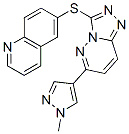All AbMole products are for research use only, cannot be used for human consumption.

SGX523 is an exquisitely selective, ATP-competitive inhibitor of the MET receptor tyrosine kinase with antitumor activity in vivo. SGX523, a novel, ATP-competitive kinase inhibitor remarkablefor its exquisite selectivity for MET. SGX523 potently inhibited MET with an IC50 of 4 nmol/L and is >1,000-fold selective versus the >200-fold selectivity of other protein kinases tested in biochemical assays. SGX523 is the most selective inhibitor of MET catalytic activity described to date and is thus a useful tool to investigate the role of MET kinase in cancer without the confounding effects of promiscuous protein kinase inhibition.
| Cell Experiment | |
|---|---|
| Cell lines | MDCK cells and A549 cells line (migration) |
| Preparation method | Scatter and Migration Assays To measure the effect of SGX523 on HGF-induced cell scatter, MDCK cells were plated at 1 × 103 per well in a 24-well plate and incubated at 37°C in 5% CO2 for 1 week in MEM and 10% fetal bovine serum. HGF (90 ng/mL) and various concentrations of SGX523 were added, and the cells were incubated for 18 h (37°C, 5% CO2 humidified incubator) and visualized. To investigate cell migration, A549 cells were plated in 12-well plates (6 × 104 per well) and incubated to confluence. A channel was introduced into the monolayers by scratching with a pipette tip. Various dilutions of compound were added in starve medium in the presence and absence of HGF (90 ng/mL). Twenty-four hours later, wells were checked for cell migration. Cells were stained and visualized as described. |
| Concentrations | 0, 0.04, 0.12, 0.36 and 3 μ M |
| Incubation time | 18h or 24h |
| Animal Experiment | |
|---|---|
| Animal models | Human GTL16 tumor xenografts in mice / U87MG tumor xenografts in mice |
| Formulation | 20% isopropanol, 200 mmol/L ammonium acetate, and 100 mmol/L Tris-HCl (pH 7.5); 25% (v/v) glycerol |
| Dosages | 10, 20, 30, and 100 mg/kg twice daily or 60 mg/kg daily starting at day 4 for 14 d / 10 or 60 mg/kg twice daily starting at day 5 for 22 d |
| Administration | oral gavage |
| Molecular Weight | 359.41 |
| Formula | C18H13N7S |
| CAS Number | 1022150-57-7 |
| Solubility (25°C) | DMSO 20 mg/mL |
| Storage |
Powder -20°C 3 years ; 4°C 2 years In solvent -80°C 6 months ; -20°C 1 month |
| Related c-Met Products |
|---|
| Zurletrectinib
Zurletrectinib (ICP-723) is a potent tyrosine kinase inhibitor. Zurletrectinib serves as an antineoplastic agent. Zurletrectinib can used for research of TRK-mediated related diseases. |
| ABN401
ABN401 is a highly potent and selective ATP-competitive c-MET inhibitor with an IC50 value of 10 nM. |
| (Z)-Semaxanib
(Z)-Semaxanib is a potent tyrosine kinase inhibitor. |
| MET kinase-IN-2
MET kinase-IN-2 is a potent, selective, orally bioavailable MET kinase inhibitor with an IC50 of 7.4 nM. |
| BMS-817378
BMS-817378 is a potent and selective inhibitor of MET with IC50 of 1.7 nM. |
All AbMole products are for research use only, cannot be used for human consumption or veterinary use. We do not provide products or services to individuals. Please comply with the intended use and do not use AbMole products for any other purpose.


Products are for research use only. Not for human use. We do not sell to patients.
© Copyright 2010-2024 AbMole BioScience. All Rights Reserved.
